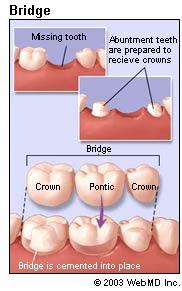Sometimes not everyone is a candidate for dental implants for a host of factors. Another solution to missing teeth is a dental bridge, that can replace one or more missing teeth.
A bridge utilizes the teeth on either side of the gap as anchoring teeth (also known as abutment teeth) -- and a false tooth/teeth in between (pontics). The bridge can be made from gold, alloys, porcelain, or a combination of these materials. It is also important to note that dental bridges can be supported by natural teeth or implants.
Why Dental Bridges?
- Bridges, with proper planning, can:
- Restore your smile
- Restore chewing and speaking function
- Maintain the shape of your lips and face
- Distribute the biting forces properly
- Prevent remaining teeth from drifting out of position
3 Types of Dental Bridges
Traditional bridges are the most common type of bridge that can be made of porcelain fused to metal or all ceramic.
(Implant/tooth) -- (Pontic/missing tooth) -- (Implant/Tooth)
Cantilever bridges are used in unique and rare treatment planning scenarios. The pontic is only attached to one adjacent tooth. This style of bridge is not recommended because it can exert too much force on tooth it is attached to.
Maryland bonded bridges is also called a resin-bonded bridge. A Maryland bridge can be made of porcelain, porcelain fused to metal, or plastic teeth. Metal or porcelain wings often on just one side of the bridge are bonded to your existing teeth. The existing used for the Maryland bridge has very minimal and conservative preparation.

What Is the Process for Getting a Dental Bridge?
During the first visit for getting a dental bridge, the abutment or adjacent teeth to the missing teeth are prepared. Preparation involves recontouring these teeth by removing tooth structure and enamel to allow room for a crown to be placed over them. Next, impressions of the teeth are made, which serve as a model from which the bridge, pontic, and crowns will be made by a dental lab. Your dentist will make a temporary bridge to wear to protect the exposed teeth and gums while the bridge is being made at the lab.
During the second visit, your temporary bridge will be removed and the new porcelain or metal bridge will be checked and adjusted to achieve proper seating. If the bridge is up to the doctor’s standard, you may leave with the bridge. Sometimes multiple visits will be required as changes may be made by the dentist or the patient. Each case is different and presents its own unique set of challenges. If both patient and dentist are happy with the end product, the bridge may be cemented or bonded in place!
How Much Do Dental Bridges Cost?
Multiple factors affect the cost of dental bridges such as the area of the country in which the procedure is performed, the materials used, and the expertise of the treating doctor. Dental insurances will typically pay a percentage of the fee depending on the individual dental plan.
How Long Do Dental Bridges Last?
Dental bridges will last however long the patient can properly take care of the bridge. With good oral hygiene and routine checkups, it is not unusual for the life span of a fixed bridge to be over 10 years.
Will It Be Difficult to Eat With a Dental Bridge?
Eating will be easier with a dental bridge. However, it will take some time to be accustomed to the bridge, so eating soft foods will help with the process.
How Do I Care for a Bridge?
The success of the bridge depends on the solid foundation of the surrounding teeth and oral cavity. Brushing twice a day, flossing and using a mouthwash daily will help prevent loss of additional teeth. It is important to understand why we lost a tooth in the first place, so that we prevent further tooth loss. You can help protect and extend the life of your dental bridge by keeping a regular cleaning schedule so that the dentist can diagnose problems at an early stage where treatment has a better prognosis.
